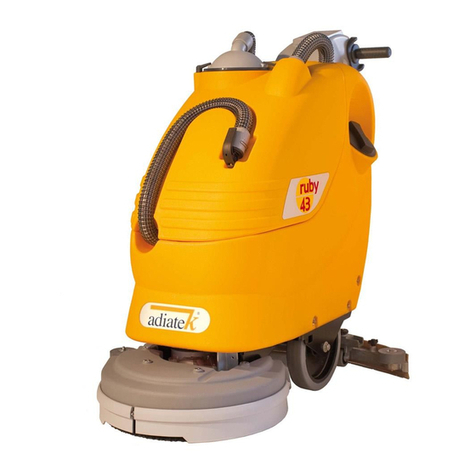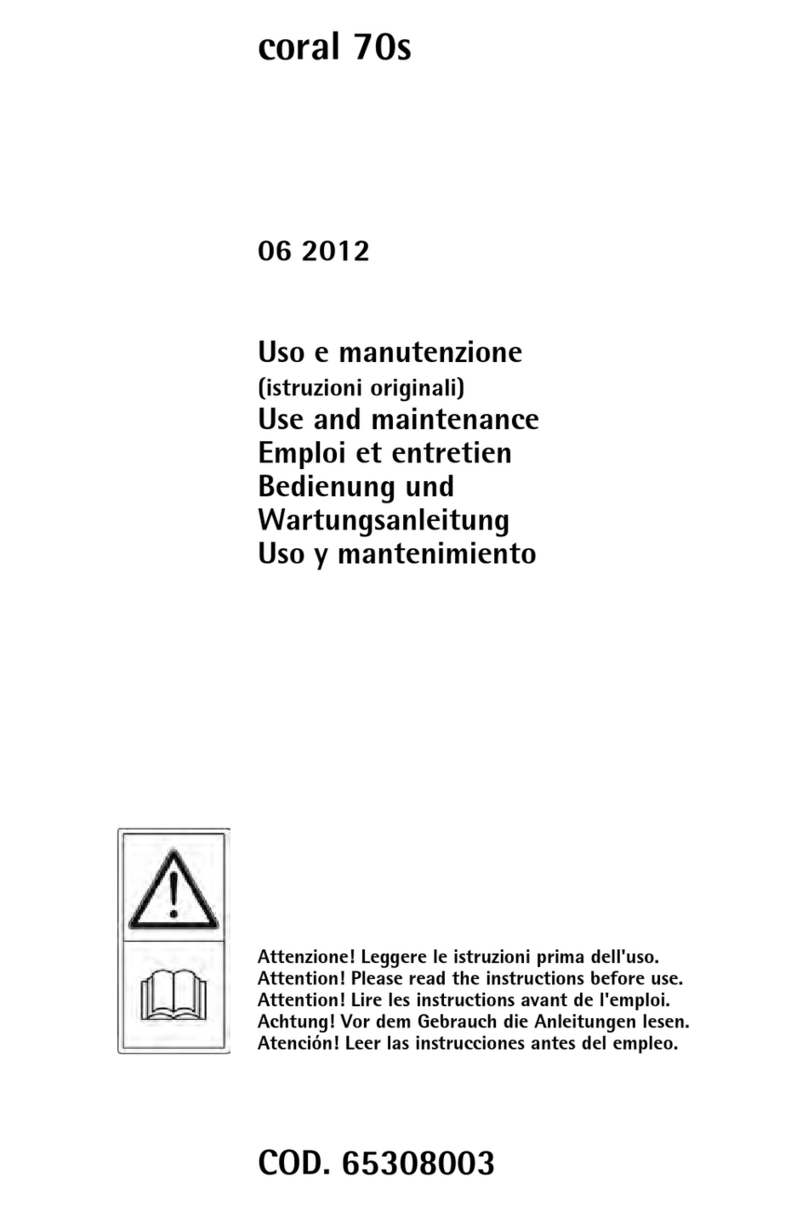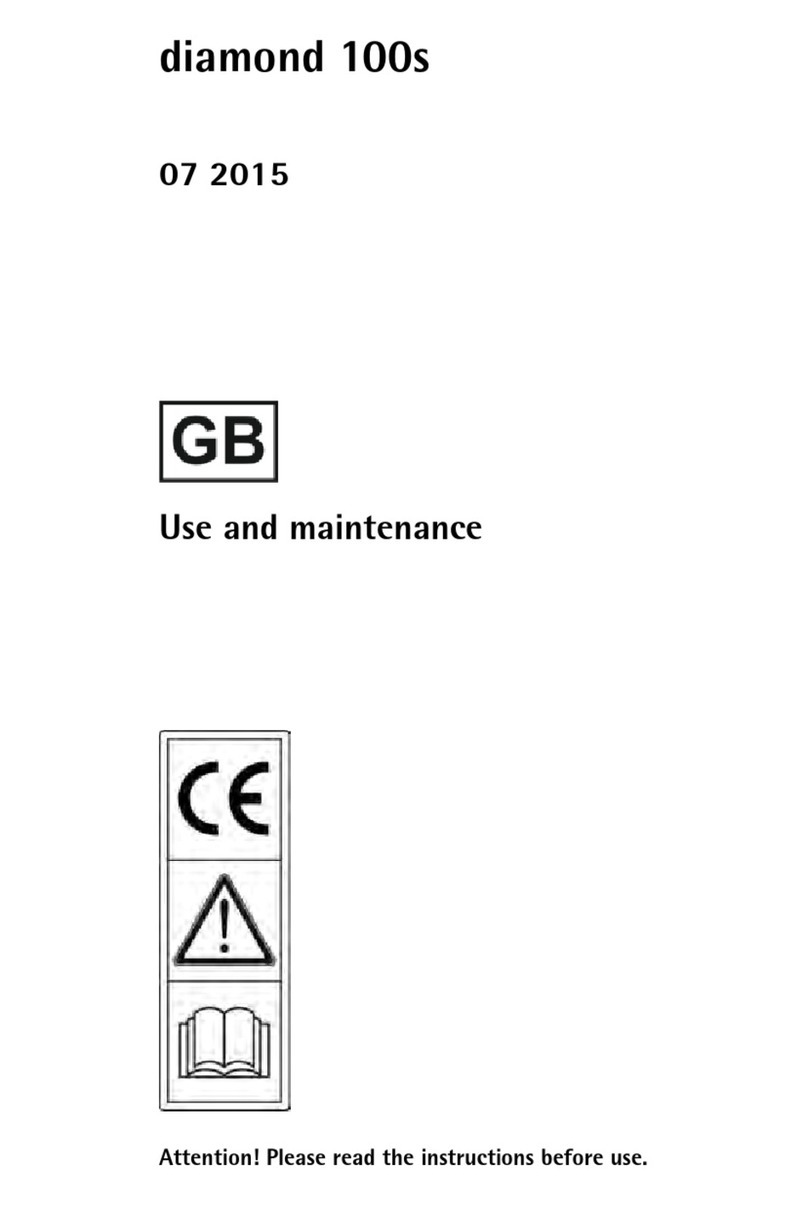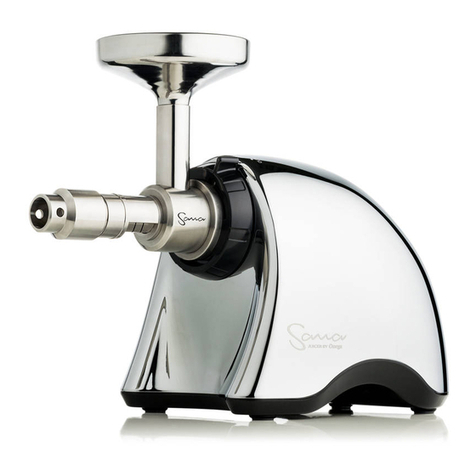
I I
PREMESSA
Vi ringraziamo per aver scelto la nostra macchina.
Questa macchina lavasciuga pavimenti viene utiliz-
zata nella pulizia industriale e civile per qualsiasi tipo
di pavimentazione esclusa la pulizia di moquettes.
Durante il moto di avanzamento l'azione combinata
della spazzola e della soluzione detergente rimuove
lo sporco il quale viene raccolto dal gruppo aspirante
posteriore, lasciando una superficie perfettamente
asciutta.
La macchina deve essere utilizzata solo per tale sco-
po. Fornisce le migliori prestazioni se usata corret-
tamente e mantenuta in piena efficienza. Vi pre-
ghiamo di leggere attentamente il presente libretto
uso e manutenzione e tenerlo sempre a disposizione.
In caso di necessità, Vi preghiamo di contattare il
nostro servizio di assistenza.
NORME GENERALI DI SICUREZZA
Le norme sotto indicate vanno seguite attentamente
per evitare danni all'operatore e alla macchina.
- Leggere attentamente le etichette sulla macchina,
non coprirle per nessuna ragione e sostituirle imme-
diatamente in caso venissero danneggiate.
- La macchina deve essere utilizzata esclusivamente
da personale autorizzato ed istruito all'uso.
- Durante il funzionamento della macchina fare at-
tenzione alle altre persone ed in particolare ai bam-
bini.
- In presenza di bambini sorvegliare la macchina in
modo che non possa accadere che giochino con la
stessa.
- Non toccare o scavalcare il cavo di alimentazione
con la spazzola in lavoro.
- La presa della rete di alimentazione deve essere
fornita di messa a terra regolamentare.
- Non danneggiare il cavo di alimentazione con pie-
gature, schiacciamenti o sollecitazioni.
- Controllare l’integrità del cavo di alimentazione. Se
in fase di lavoro si nota un danneggiamento, fermare
immediatamente la macchina e sostituirlo.
- Non mescolare detergenti di tipo diverso per evita-
re la produzione di gas nocivi.
- Temperatura di magazzinaggio: tra 0°C e +55°C.
- Temperatura ottimale di lavoro: tra 0°C e 40°C.
- L'umidità non deve superare il 95%.
- Non usare la macchina in atmosfera esplosiva.
- Non usare la macchina come mezzo di trasporto.
- Non percorrere le scale.
- Non utilizzare soluzioni acide che potrebbero dan-
neggiare la macchina e/o le persone.
- Evitare che la spazzola lavori con la macchina fer-
ma per non provocare danni al pavimento.
- Non usare la macchina su superfici cosparse di li-
quidi o polveri infiammabili (ad esempio idrocarburi,
ceneri o fuliggine).
- In caso di incendio usare estintori idonei.
Non usare acqua.
- Non urtare scaffalature o impalcature dove esista il
pericolo di caduta di oggetti.
- Non utilizzare l'apparecchio su superfici aventi
un'inclinazione superiore a quella indicata in targa.
- La macchina deve eseguire le operazioni di lavaggio
ed asciugatura contemporaneamente. Operazioni di-
verse dovranno essere eseguite in zone vietate al
passaggio di persone non addette e l’operatore dovrà
indossare calzature adeguate.
- Segnalare le zone di pavimento umido con appositi
cartelli segnalatori.
- Quando si dovessero riscontrare anomalie nel fun-
zionamento della macchina, accertarsi che non siano
dipendenti dalla mancata manutenzione ordinaria. In
caso contrario richiedere l'intervento del centro assi-
stenza autorizzato.
- In caso di sostituzione di pezzi, richiedere i ricambi
ORIGINALI ad un Concessionario e/o Rivenditore
Autorizzato.
- Impiegare solamente spazzole ORIGINALI indicate
nel paragrafo "SPAZZOLE CONSIGLIATE".
- Per ogni intervento di pulizia e/o manutenzione
togliere l'alimentazione elettrica dalla macchina.
- Non togliere le protezioni che richiedano l'uso di
utensili per essere rimosse.
- Non lavare la macchina con getti d'acqua diretti o
in pressione, o con sostanze corrosive.
- Ogni 200 ore far controllare la macchina da un
centro di assistenza autorizzato.
- Prima di utilizzare la macchina, verificare che tutti
gli sportelli e le coperture siano posizionati come in-
dicato nel presente manuale uso e manutenzione.
- Ripristinare tutti i collegamenti elettrici dopo qual-
siasi intervento di manutenzione.
- Provvedere allo smaltimento dei materiali di con-
sumo attenendosi scrupolosamente alle norme di
legge vigenti.
- Quando la Vostra macchina dovrà cessare l'attività,
provvedere allo smaltimento appropriato dei mate-
riali in essa contenuti specialmente oli e componenti
elettronici, e tenendo conto che la macchina stessa è
stata costruita, per quanto possibile, con l'impiego di
materiali riciclabili.
SIMBOLOGIA
Indica l’interruttore e la spia
dell’elettrovalvola.
Indica l'interruttore e la spia del
motore spazzola.
Simbolo del motore aspirazione.
Indica l'interruttore e la spia del
motore aspirazione.
Simbolo che indica la posizione
del tappo di scarico del
serbatoio soluzione.
Simbolo che indica di svuotare i
serbatoi prima di ruotare la
macchina.
temperatura massima della
soluzione detergente.
Simbolo che indica il regolatore
di flusso della soluzione
detergente.
Simbolo del bidone barrato.
Indica che alla fine della propria
vita utile la macchina dovrà
essere smaltita in conformità
alla legislazione vigente.
Simbolo del libro aperto.
Indica all’operatore di leggere i
manuali prima dell’uso della
macchina.
Leggere attentamente le sezioni
precedute da questo simbolo,
per la sicurezza dell'operatore e
della macchina.
Simbolo che indica il modo corretto di trasferire la
macchina su percorsi comunque accidentati.
6



































